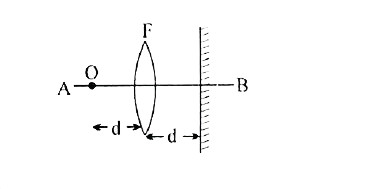_S01_029_Q01.png)
In the figure shown S is a point monochromatic light source of frequency .M is a concave mirror of radius of curvature 20 cm and L is a thin converging lens of focal length 3.75 cm AB is the principal axis of M and L.
Light reflected from the mirror and refracted from the lens in succession reaches the screen. An interference pattern is obtained on the screen by this arrangement.
Q. Fringe width is
1 mm
0.5 mm
1.5 mm
0.25 mm
The correct Answer is:B
Topper's Solved these Questions
- WAVE OPTICSBook:ALLENChapter:WAVE OPTICSExercise:Example 12
Explore 1 Video
- WAVE OPTICSBook:ALLENChapter:WAVE OPTICSExercise:Example 13
Explore 1 Video
- WAVE OPTICSBook:ALLENChapter:WAVE OPTICSExercise:Example 10
Explore 1 Video
- UNIT & DIMENSIONS, BASIC MATHS AND VECTOR Book:ALLENChapter:UNIT & DIMENSIONS, BASIC MATHS AND VECTOR Exercise:Exercise (J-A)
Explore 7 Videos
Similar Questions
A converging lens of focal length 5 cm is placed at a distance of 20 cm from a screen. How far from the lens should an object be placed so as to form its real image on the screen?
View SolutionA luminous object is placed at a distance of 40 cm from a converging lens of focal length 25 cm. The image obtained in the screen is
View Solution
Knowledge Check
_S01_028_Q01.png)
In the figure shown S is a point monochromatic light source of frequency 6×1014Hz.M is a concave mirror of radius of curvature 20 cm and L is a thin converging lens of focal length 3.75 cm AB is the principal axis of M and L.
Light reflected from the mirror and refracted from the lens in succession reaches the screen. An interference pattern is obtained on the screen by this arrangement.
Q. Distance between two coherent sources whichmakes interference pattern on the screen isA1 mmB0.5 mmC1.5 mmD0.25 mm_S01_030_Q01.png)
In the figure shown S is a point monochromatic light source of frequency 6×1014Hz.M is a concave mirror of radius of curvature 20 cm and L is a thin converging lens of focal length 3.75 cm AB is the principal axis of M and L.
Light reflected from the mirror and refracted from the lens in succession reaches the screen. An interference pattern is obtained on the screen by this arrangement.
Q. If the lens is replaced by another converging lens of focal length 103cm and the lens is shifted towards right by 2.5 cm thenAfringe width remains sameBintensity of pattern will remain sameCfringe width will changeDNo interference pattern will form.An illuminated object is placed at a distance of 20 cm from a converging lens of focal length 15 cm. The image obtained on the screen is:
Aupright and magnifiedBinverted and magnifiedCinverted and diminishedDupright and diminished.
In the figure shown L is a converging lens of foacl length 10cm and M is a concave mirror of radius of curvature 20cm. A point object O is placed in front of the lens at a distance 15cm.AB and CD are optical axes of the lens and mirror repectively. Find the distance of the final image formed by this system from the optical centre of the lens. The distance between CD&AB is 1cm

View SolutionIn the figure shown ‘O’ is point object. AB is principal axis of the converging lens of focal length F. Find the distance of the final image from the lens.

View SolutionA concave lens of focal length 20 cm is placed 15 cm in front of a concave mirror of radius of curvature 26 cm and further 10 cm away from the lens is placed an object. The principal axis of the lens and the mirror are coincident and the object is on the axis Find the position and nature of the image.
View SolutionAn illuminated object is placed at a distance of 20 cm from a converging lens of focal length 15 cm. The image obtained on the screen is:
View SolutionIn the figure shown L is converging lens of focal length 10 cm and M is a concave mirror of radius of curvature 20 cm . A point object O is placed in front of the lens at a distance 15 cm . AB and CD are optical axes of the lens mirror respectively. Find the coordinates of the final image formed by this system taking O as origin. The distance between CD & AB is 1mm.
_E01_138_Q01.png)
View Solution

